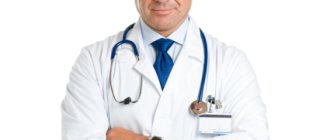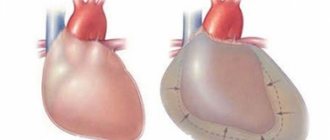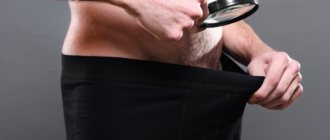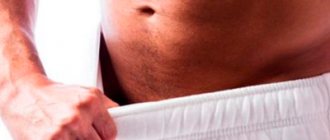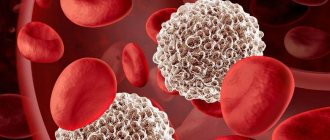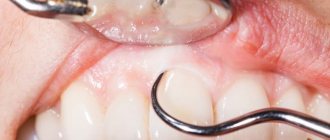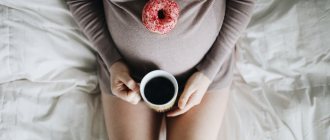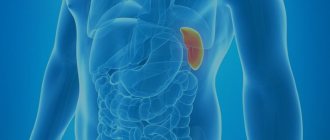Useful articles
Publication date:
Based on statistics, it can be noted that men suffer from migraines less often than women. Migraine manifestations have their own characteristics and differences. The stronger sex endures pain much harder, is less resistant to regular stress and is constantly exposed to a large number of external negative factors. In addition, migraines in men are more aggressive and severe. In practice, the frequency of attacks in male patients is lower than in female patients. These features are of great importance when developing tactics for treating migraine in men.
general information
According to statistics, at least every tenth person on the planet suffers from migraine.
Women get sick approximately twice as often as men. This is associated with cyclical hormonal changes during the menstrual cycle. Typically, the disease makes itself felt before the age of 30-35; cases of the pathology occurring in childhood have also been described.
The biomechanism of the development of the disease is not precisely known. There are several theories about the occurrence of pain and accompanying symptoms, the most popular of which is neurovascular. According to this point of view, migraine begins against the background of activation of the trigeminal nucleus, which first causes spasm and then dilation of cerebral vessels. As a result, the tissue around the arteries becomes swollen, which leads to pain. In addition, the pathological process is associated with impaired serotonin metabolism.
Some scientists believe that pain occurs solely against the background of a sharp spasm and subsequent relaxation of blood vessels, resulting in tissue swelling (vascular theory). It has been clearly proven that the risk of developing the disease is significantly higher in women, as well as in people whose parents or close relatives also suffered from migraine.
Make an appointment
Why does migraine occur?
Neurology describes more than two hundred types of headaches of various origins. Broadly speaking, they are divided into two groups. Primary cephalgia is not associated with any diseases, secondary ones are symptomatic.
Migraine is a primary headache. It is considered a neurovascular syndrome and has long been thought to result from irritation or compression of the neurovascular bundle. But now the disease is associated with increased excitability of certain groups of nerve cells in the brain. Research shows that these neurons have unstable biochemical activity and electrical excitability. Therefore, under the influence of several trigger factors, they are activated and transmit excitation to neighboring cells, forming a focus. The mechanism of propagation of an electrical impulse is similar to an epileptic attack, but this is a completely different disease.
The causes of migraine can be:
- genetic predisposition;
- endocrine disorders;
- stress and sleep disorders;
- poor nutrition;
- weather sensitivity.
In women, the manifestation of primary cephalgia is associated with changes in hormonal levels. Thus, when estrogen levels decrease, migraine episodes become more frequent, and when estrogen levels increase, they disappear. The first attacks may coincide with the first menstruation, but often begin after 30 years. Migraine usually disappears after pregnancy, it practically does not occur in the 2nd and 3rd trimesters.
Certain foods can act as triggers. Each person will have an individual list of them, but most often the connection is traced with the consumption of chocolate, cocoa, coffee, alcohol, strong tea, red wine, beer, legumes or cheese. Therefore, if such a connection is established, it is better to exclude the product from the diet.
Sometimes attacks occur after head and neck injuries, which may be due to a disruption in the blood supply to a certain area of the brain. Mandibular joint dysfunction can also lead to chronic migraines.
In children, attacks occur due to mental or physical fatigue; they can appear after a change of team or place of residence, or other stressful situations.
Causes
Migraine occurs against the background of various external and internal causes (triggers), each of which can cause another attack:
- mental and psycho-emotional stress;
- constant severe stress;
- sleep disturbances, insufficient rest at night;
- chronic fatigue (mental and physical);
- smoking;
- previous head injuries (even many years ago);
- excessive physical activity for a particular person;
- hormonal surges: puberty, menstruation (“menstrual migraine”), pregnancy;
- consumption of foods containing tyramine (chocolate, coffee, citrus fruits, nuts, cheese, smoked meats);
- drinking alcohol, especially low-alcohol drinks;
- sharp fluctuations in atmospheric pressure, changes in air temperature;
- overstrain of the senses: sharp sound, bright light, strong unpleasant odor, etc.;
- staying in a hot or stuffy room, etc.
Each person has his own “dangerous” factors. Most of them can be calculated and, if possible, avoided in the future.
Symptoms
A migraine attack follows a standard scenario, consisting of several successive stages.
- Prodromal (initial) stage. A person’s mood begins to change, yawning and drowsiness appear, or, conversely, insomnia. Some report sensitivity to noise and bright light. Sometimes there is a slight numbness in one of the hands. For most patients, these symptoms are enough to know that a full-blown migraine attack is on the way. The duration of the prodromal stage ranges from several hours to several days; it is not present in all patients.
- Aura. Occurs against the background of cerebral vascular spasms. Most often it manifests itself in the form of visual disturbances (flashes in the form of spots, zigzags or lightning in front of the eyes, distortion of the contours of objects, loss of individual fields of vision). Less common are taste or hearing disorders, problems with coordination of movements, etc. Aura is not observed in all patients.
- Actually a migraine attack. In most cases, it manifests itself as a unilateral headache that is pulsating in nature. It starts with slight discomfort and gradually gains strength, becoming simply unbearable. Movements, changes in body position, bright lights and loud sounds intensify the sensations, which is why patients try to spend this time lying in a darkened room. Against the background of a headache, many patients report nausea, vomiting, soreness in the muscles of the neck and shoulders, nasal congestion, lacrimation, chills and even fever. The duration of the attack is individual and ranges from 2-3 hours to several days.
- Resolution stage. At this time, the headache goes away on its own or after taking medications. Many patients fall asleep at first, but within 24 hours after the attack they may feel weak, lethargic, dizzy, and depressed. Increased sensitivity to light, sounds and smells also does not go away immediately. Less common is the opposite type of resolution stage, in which patients note increased activity.
What is migraine
Migraine is a neurological disorder characterized by unilateral headaches. In some cases, it is accompanied by a set of concomitant vegetative symptoms. Because of them, migraine can be confused with other diseases.
The disease occurs more often in women and can be hereditary. There is a rare type of hemiplegic migraine that is associated with changes in genes on chromosomes 1, 2, and 19. But the role of these pieces of genetic material in the formation of common migraines is still being studied.
Not every headache fits the definition of a migraine. Usually the pathology occurs unilaterally, and the intensity of pain varies. The first signs appear on average at the age of 30 and gradually progress. But there have been rare cases of migraine headaches appearing in children as young as 3 years old. Moreover, boys suffer from migraines more often than girls. And with age, this ratio changes in favor of women.
The exact causes of the pathology are unknown, but it is considered a multifactorial disease. The peculiarity of the course of the pathology is that in women, as menopause approaches, the condition may worsen. But after menopause it stabilizes and the symptoms gradually disappear.
Types of pathology
Migraines are most often classified according to the presence of an aura and its type. The following types of disease are distinguished:
- classic migraine: before an attack of pain, a typical aura occurs with visual, auditory, olfactory and other disturbances;
- migraine without aura: symptoms appear suddenly against a background of relative well-being; the rest of the clinical picture is characteristic of the disease.
Depending on the predominant symptoms, the following types of migraine are distinguished:
- ocular (ophthalmic): accompanied by classic visual impairments: glare, flickering, flare in certain areas of the visual field;
- retinal: the disease manifests itself as complete or partial loss of vision in one eye due to impaired blood circulation in the vessels of the retina;
- ophthalmoplegic: manifested by double vision, visual distortions, drooping of the eyelid;
- basilar: accompanied by dizziness, ringing in the ears, unsteadiness when walking, blurred speech;
- hemiplegic: characterized by loss of sensation and impairment of motor function of one arm or arm and leg on one side;
- cervical: occurs against the background of impaired blood flow in the vertebral arteries and is accompanied by a very severe headache;
- aphasic: pain is accompanied by speech disorders, as with a stroke;
- abdominal: additionally manifests itself as severe pain throughout the abdomen, diarrhea, nausea and vomiting; this form is very common in children;
- “decapitated”: the patient does not feel a headache, as a rule, only visual disturbances are noted, while the prodromal period and aura occur typically.
Migraine status stands apart. This is a severe condition in which two or more attacks occur in a row with less than 4 hours between them. This type also includes pain that lasts for more than 3 days. Against the background of migraine status, the patient experiences repeated vomiting, which does not allow him to eat, drink, or take medications normally.
How to help someone with migraine
Since this type of cephalgia is not a symptom of the disease, it is necessary to eliminate the provoking triggers. To do this you need:
- normalize nutrition;
- avoid skipping meals;
- get enough sleep;
- reduce mental stress;
- engage in moderate physical activity;
- relieve stress.
If you don't know exactly what causes a headache, it can be helpful to keep a diary and write down what preceded the next attack. But it is not recommended to carry out drug therapy on your own. Headache attacks may conceal more serious pathologies that require special treatment. It can be:
- malignant neoplasms of the nervous system;
- transient ischemic attack;
- ischemic cerebral stroke;
- subarachnoid hemorrhage;
- dissection of the carotid or vertebral artery;
- cerebral vasculitis.
For the treatment of migraine, medications are selected depending on the intensity of the attack. For mild forms, non-steroidal painkillers can be used. Evidence of effectiveness is available for the following medicines:
- Aspirin tablets;
- Paracetamol in tablets or suppositories;
- Ibuprofen tablets;
- Diclofenac tablets or injections.
Sometimes, for greater effectiveness, a combination of different types of non-steroidal anti-inflammatory drugs is prescribed: Brustan, Trigan, Panoxen. It is effective to add caffeine to the therapy regimen, as in the tablets Solpadeine Fast, Askofen, Citramon.
If painkillers are ineffective, triptans are included in the treatment regimen. This is a class of substances that are effective in 75% of patients with headaches. They are marketed under the names Sumatriptan and Sumamigren. These drugs have few side effects, but can cause myocardial ischemia in patients with diseases of the cardiovascular system. For those for whom triptans are not contraindicated, the effect can be enhanced with naproxen.
For those for whom triptans are contraindicated, metoclopramide is prescribed. It helps relieve headache attacks and is often used as an emergency remedy. Also in development are new generation drugs that are agonists of serotonin receptors or belong to the group of monoclonal antibodies that block an excess of a certain neurotransmitter.
In children, the only approved drugs are ibuprofen or paracetamol. In adolescence, it is allowed to use their combination Ibuklin Junior.
Diagnostics
The patient's headache has characteristic features that immediately suggest a migraine. For diagnosis, the doctor uses the following methods:
- collecting complaints and medical history to determine the nature of the pain; special attention is paid to: the time of onset and end of the attack;
- provoking factors;
- nature of pain;
- the absence or presence of an aura, its symptoms;
- well-being after an attack;
If necessary, additional examinations and consultations with specialists are prescribed. The diagnosis of migraine is made by exclusion when no other causes of headache have been identified.
Make an appointment
Treatment
Migraine treatment is divided into two areas:
- relief of the patient’s condition during an attack;
- preventing the occurrence of new attacks.
Help during a seizure
At the first signs of an impending migraine attack, it is necessary to eliminate as quickly as possible all factors that can increase the pain:
- turn off the lights and TV, close the curtains;
- eliminate sources of extraneous sounds as much as possible;
- provide access to fresh, cool air;
- go to bed.
To prevent and relieve immediate pain attacks, painkillers of various groups are used:
- analgesics and non-steroidal anti-inflammatory drugs (analgin, ibuprofen, indomethacin and their analogs): used for mild attacks that do not affect a person’s daily life;
- combination drugs (codeine, tempalgin, solpadeine): prescribed for moderate attacks that have little effect on life activity;
- triptan drugs (amigrenin, sumamigren, zomig and others) are used if attacks interfere with normal life;
- hormonal drugs (dexamethasone): used for severe and prolonged migraines in combination with other medications.
Additionally, antiemetics (metoclopramide, cerucal) can be used.
Home remedies to prevent a migraine attack are used as an addition to the main therapy. Many patients benefit from:
- cold compress on forehead;
- rubbing essential oils into the temple area;
- infusion of chamomile, mint, lemon balm, lavender and other herbs that promote relaxation;
- acupressure on acupuncture points: at the base of the skull, between the eyebrows in the hollow above the bridge of the nose, on the back of the foot (the hollow between the first and second toes).
It is important to remember that these remedies do not replace primary therapy.
Treatment between attacks
Preventing the occurrence of attacks is no less important than relieving pain and nausea. Currently, various groups of drugs are used:
- beta-blockers (propranolol and drugs based on it);
- antidepressants (venlafaxine, milnacipran, etc.): have a good effect in the treatment of chronic pain, and also reduce the manifestations of depression characteristic of patients with frequent attacks;
- anticonvulsants (Depakine, topiramate): well tolerated and significantly reduce the frequency of exacerbations.
Medicines are used:
- if exacerbations occur more than 2 times a month;
- if attacks last more than 48 hours;
- with severe headache or complications.
In other cases, general preventive measures are sufficient.
How does the disorder develop?
Migraine of this form develops in two stages. At first, the changes are still reversible, so with proper therapy, the problem is completely eliminated. When the treatment period is missed, it is no longer possible to completely cure the patient, and only therapy is required aimed at relieving pain during an attack and reducing the frequency of spasms.
1. Initial reversible stage. In this condition, vasoconstriction does not occur often, and attacks pass fairly quickly. Additional symptoms, except headache, are mild or completely absent. Due to the rarity of attacks, not everyone seeks medical help, attributing disturbances to overwork or stress.
2. Second irreversible stage. With it, the narrowing of the artery walls is very pronounced and almost constant. Spinal disorders are serious and cannot be corrected. The frequency and intensity of attacks increase significantly, and clear additional symptoms appear. With the help of treatment, it is no longer possible to return the vessels to their normal state and restore full cerebral circulation. Moderate headaches become an almost constant occurrence.
The longer you delay visiting a doctor, the higher the likelihood that the changes will be irreversible.
Prevention
Prevention of migraine attacks is not only properly selected drug therapy, but also correction of the patient’s lifestyle. Doctors recommend:
- normalize sleep: for the normal functioning of the body, at least 8 hours of night sleep every day are required;
- minimize the consumption of foods that can cause an attack, especially chocolate, spices, and alcoholic beverages;
- eliminate smoking;
- adhere to a balanced diet with a mandatory breakfast and intervals between meals of no more than 5 hours;
- observe the drinking regime and consume at least 1.5-2 liters of clean water per day; in hot weather this amount can reach 2.5-3 liters;
- establish a work and rest schedule, avoid mental and physical fatigue;
- reduce stress levels as much as possible;
- make a habit of light or moderate physical activity: swimming, walking, cycling, yoga, Pilates;
- promptly identify and treat chronic diseases, especially osteochondrosis of the cervical spine, atherosclerosis and other pathologies that contribute to the deterioration of blood flow in the brain.
Regular health resort treatment of a restorative nature and tourist trips without extreme changes in climate and time zones have a good effect.
Treatment at the Energy of Health clinic
Neurologists at the Health Energy clinic are ready to help with migraines of any severity. We offer each patient:
- individual selection of drugs for the relief and prevention of attacks;
- training in relaxation and self-help techniques;
- sessions of restorative massage and physical therapy in the absence of contraindications.
Treatment is selected according to the individual characteristics of the body. Before prescribing a specific regimen, a complete examination of the patient is carried out to exclude other causes of headache.
Quick help
At the initial stage of the next attack, you can drink sweet tea. Raising your blood sugar may stop your headache from getting worse. It is recommended to perform acupressure on the back of the head and neck, pressing on the occipital protuberance and carotid arteries with the fingertips. Such actions can delay the pain until the pill takes effect.
Herbal teas, sedatives, hot showers, and warming the feet have a positive effect on overall well-being.
Advantages of the clinic
Medical facilities are equipped in accordance with modern standards of diagnosis and treatment of diseases. We try to make every patient feel comfortable within the walls of the clinic and offer:
- consultations with doctors of various specialties;
- informative methods of instrumental, functional and laboratory diagnostics;
- individual selection of treatment regimen;
- complex effect on the body using not only drugs, but also additional methods: physiotherapy, massage, exercise therapy, manual therapy, etc.
Reception is by appointment, without queues or long waits. The location of the centers allows both motorists and those traveling by public transport to reach us comfortably.
If migraine attacks are making your life miserable, do not endure the pain. Contact the neurologists at Health Energy. Together we will find a way to relieve you of this disease.
Forecast
The prognosis for the patient depends on the moment at which treatment is started. If treatment for the disease is started in a timely manner, the prognosis is positive, since it is possible to restore normal blood circulation and eliminate the pathology. When the case is advanced, the prognosis ranges from unfavorable to serious, since it is not always possible to improve the patient’s condition, even resorting to surgery to restore blood circulation. Most often, the walls of blood vessels become narrowed irreversibly.

